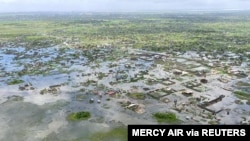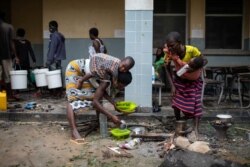Humanitarian operations are underway to provide life-saving assistance to tens of thousands of people in Mozambique devastated by Tropical Cyclone Eloise. At least six people reportedly have died and more than 176,000 have been affected.
Tropical Cyclone Eloise made landfall Saturday, dumping torrents of rain in areas already affected by Tropical Storm Chalane, which flooded large areas of Mozambique three weeks ago.
The U.N. Office for the Coordination of Humanitarian Affairs reports 32 accommodation centers have been opened up in the heavily affected Sofala province. The centers are providing temporary shelter for more than 15,000 families.
OCHA spokesman Jens Laerke says survivors of this destructive cyclone are in urgent need of food, tents, drinking water, mosquito nets, COVID-19 prevention materials and other essential relief.
“The cyclone destroyed, damaged or flooded more than 8,800 houses in Mozambique and at least 26 health centers have been damaged," he said. "Large areas of crops have been flooded which raise concern for the annual harvest which is expected in April. Again, these numbers may go up when we get more assessment results.”
A recent analysis of the food and malnutrition situation in Mozambique indicates more than 2.9 million people face high levels of food insecurity in rural and urban areas in southern, central and northern provinces.
World Food Program spokesman Tomson Phiri says his agency, along with the government and partners, is currently assessing the needs to have a full picture of the storm’s impact.
“Whilst the full extent of the need will be revealed once ongoing assessments have been concluded, early indications are that the storm has aggravated further the precarious food security situation in Sofala province. People need food assistance now to cope and will need support to re-establish their livelihoods going forward,” he said.
Aid agencies express concern about the extra level of danger posed by COVID-19. They say it is very difficult to maintain social distancing in displacement centers where people are in enclosed areas with little or no ventilation.
The International Organization for Migration reports its staff is distributing soap and hygiene materials and a limited supply of cloth face masks to the most vulnerable and encouraging people to do their best to keep their distance from others.








